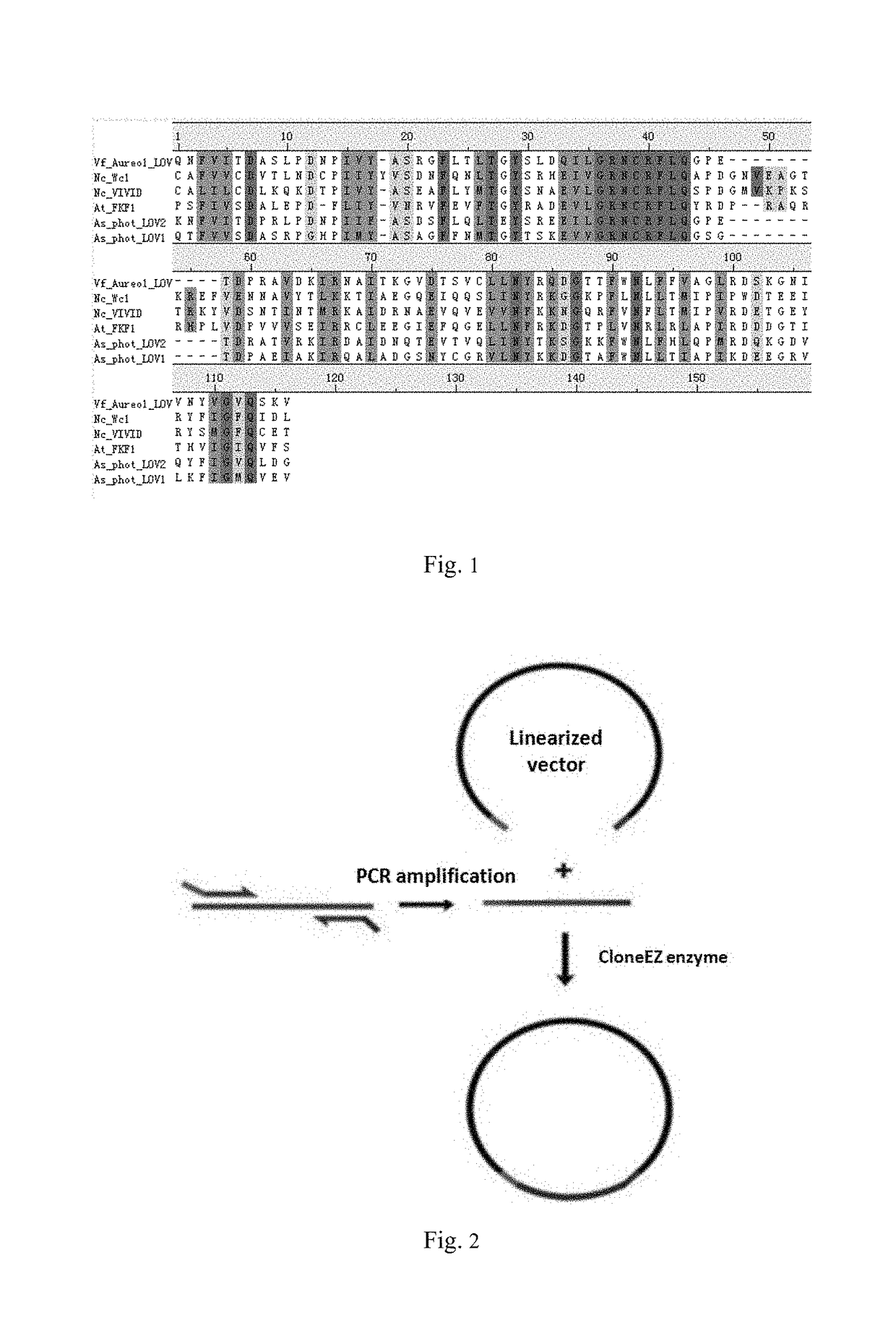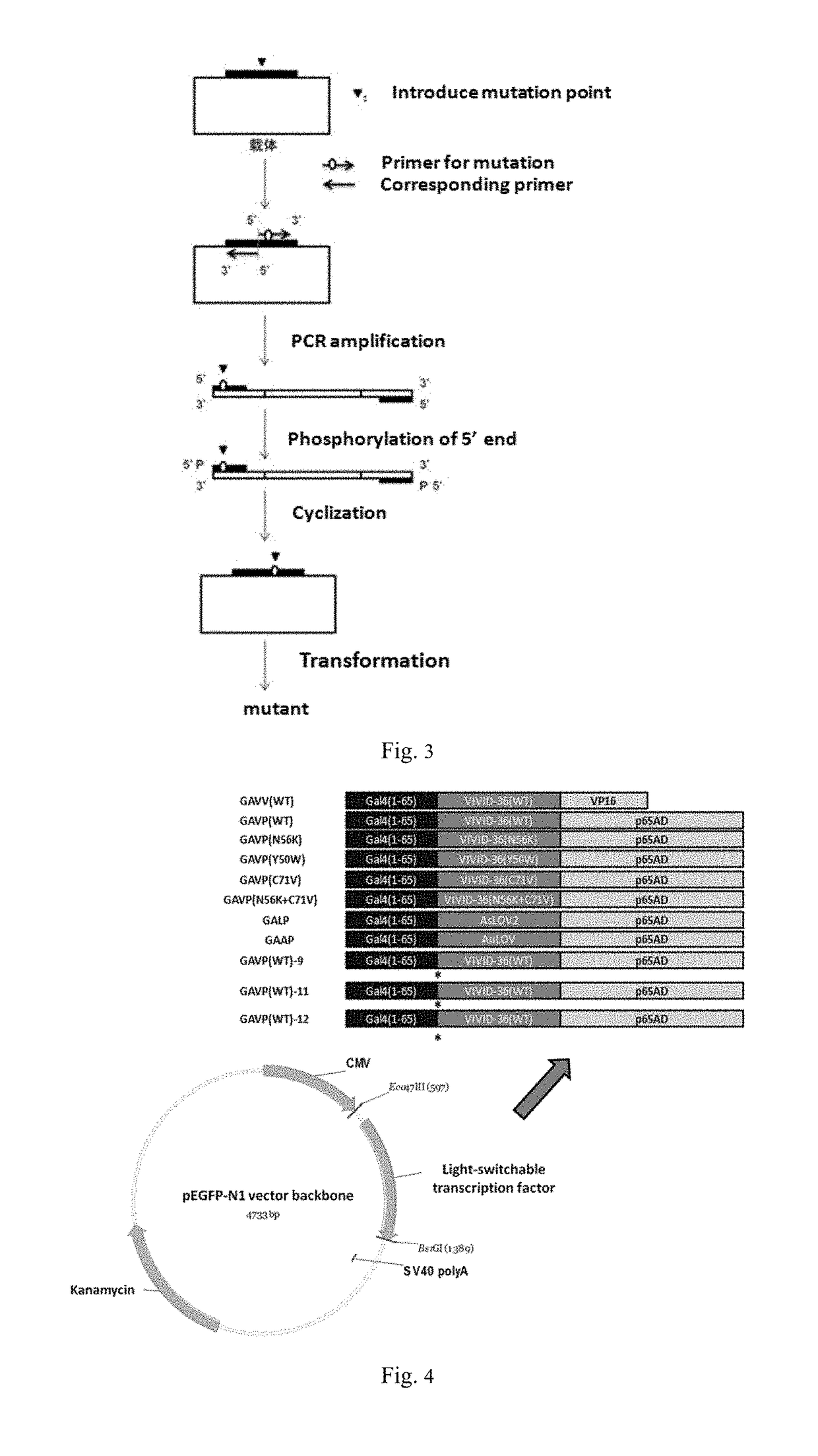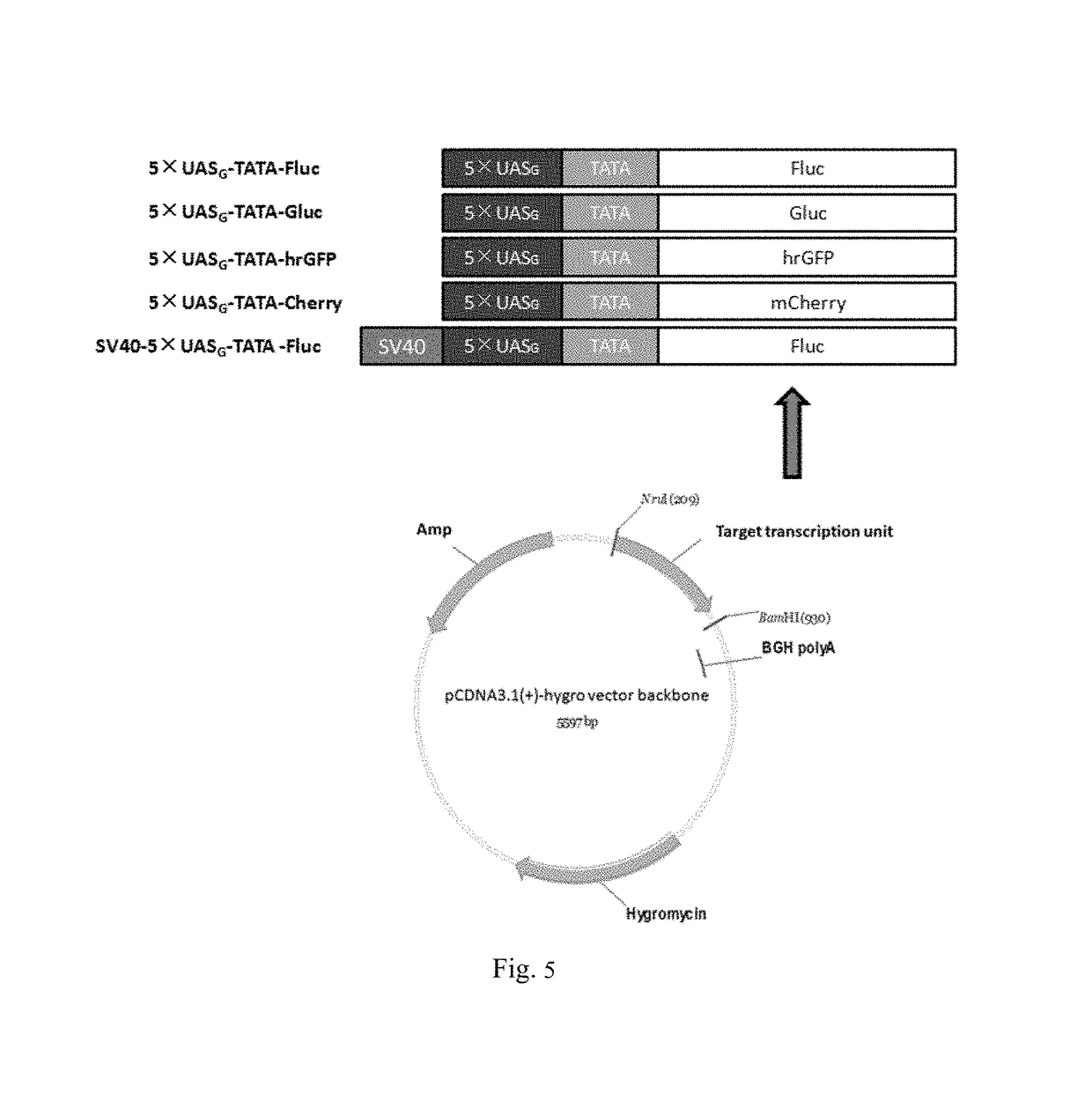Light-switchable gene expression system
a gene expression and switchable technology, applied in the field of gene expression and inducible gene expression system, can solve the problems of complex devices, high cost, and inability to express,
- Summary
- Abstract
- Description
- Claims
- Application Information
AI Technical Summary
Benefits of technology
Problems solved by technology
Method used
Image
Examples
example 1
ion of Mammalian Cell Expression Vectors Containing the Recombinant Light-Switchable Transcription Factors Using VP16, p65 or KRAB as the Third Polypeptide
[0160]Plasmids construction of this example is shown in FIG. 4. The Gal4 (1-65 amino acid) gene was amplified from pBIND (Promega) by PCR using primer P1, P2; The VP16 gene was amplified from pACT (Promega) by PCR using primer P3, P4. After extracting the genomic DNA of Neurospora crassa by using Trizol Kit (Invitrogen), the intact VIVID gene was amplified by using primers P5 and P6. The resulted VIVID gene contained two introns. Then introns were removed by reverse PCR (see FIG. 3) using primer P7, P8, P9 and P10 as primers to obtain cDNA (SEQ ID NO: 21). Gal4, VIVID-36 and VP16 genes were fused by overlap PCR (see FIG. 8), and inserted into pEGFP-N1 vector (Clontech) by Eco47III and BsrGI digestion, the resulted mammalian cell expression vectors was named pGAVV(WT), which contains the fusion protein gene of recombinant light-swi...
example 2
ion of Mammalian Cell Expression Vectors Containing the Recombinant Light-Switchable Transcription Factors Using VIVID Mutants or AsLOV2 or AuLOV as the Second Polypeptide
[0177]Refer to FIG. 4 for the plasmid construction of this example. VIVID of pGAVP (WT) described in example 1 was mutated into C71V or Y50W or N56K by reverse PCR using primers 13, 14, 15, 16, 17 and 18, the resulting mammalian cell expression vectors were named as pGAVP (C71V) (SEQ. ID. No:33 (polynucleotide) and 34 (polypeptide)), pGAVP (Y50W) (SEQ. ID. No:35 (polynucleotide) and 36 (polypeptide)) and pGAVP (N56K) (SEQ. ID. No:37 (polynucleotide) and 38 (polypeptide)), respectively.
[0178]Primer sequences was as follows:
[0179]
pGAVP (C71V):Forward primer (P13):5′-GTTGCTCTGATTCTGTGCG-3′Reverse primer (P14):5′-TGACGTGTCAACAGGTCCC-3′pGAVP (Y50W):Forward primer (P15):5′-GCTGATTCAGATTATGAACAGGC-3′Reverse primer (P16):5′-CAGCCCATAATGTCATAACCGC-3′pGAVP (N56K):Forward primer (P17):5′-GAGGCCAAACCCCCAAGTAG-3′Reverse primer ...
example 3
ion of Mammalian Cell Expression Vectors Containing the Recombinant Light-Switchable Transcription Factors Using Different Linkers Between the First Polypeptide and Second Polypeptide
[0187]Refer to FIG. 4 for the plasmid construction of this example. Linker between the first polypeptide and the second polypeptide of pGAVP (WT) described in Example 2 was optimized. pGAVP(WT) was amplified by reverse PCR using primers 23-28 to add different linkers between the first peptide and the second peptide, the resulting mammalian cell expression vectors were named as pGAVP(WT)-9, pGAVP(WT)-11 and pGAVP(WT)-12 containing recombinant light-switchable transcription factor GAVP(WT)-9 (SEQ. ID. No:59 (polynucleotide) and 60 (polypeptide)), pGAVP(WT)-11 (SEQ. ID. No:61 (polynucleotide) and 62(polypeptide)), pGAVP(WT)-12 (SEQ. ID. No:63 (polynucleotide) and 64 (polypeptide)), respectively.
[0188]Primer sequences were as follows:
[0189]
pGAVP (WT)-9Forward primer (P23):5′-AGATCCATCGCCACCAGATCTCATACGCTCTA...
PUM
| Property | Measurement | Unit |
|---|---|---|
| diameter | aaaaa | aaaaa |
| emission wavelength | aaaaa | aaaaa |
| excitation wavelength | aaaaa | aaaaa |
Abstract
Description
Claims
Application Information
 Login to View More
Login to View More - R&D
- Intellectual Property
- Life Sciences
- Materials
- Tech Scout
- Unparalleled Data Quality
- Higher Quality Content
- 60% Fewer Hallucinations
Browse by: Latest US Patents, China's latest patents, Technical Efficacy Thesaurus, Application Domain, Technology Topic, Popular Technical Reports.
© 2025 PatSnap. All rights reserved.Legal|Privacy policy|Modern Slavery Act Transparency Statement|Sitemap|About US| Contact US: help@patsnap.com



